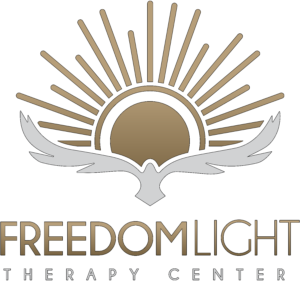Owasso, OK 74055
Call/Text: (539) 525-5356
Email: info@freedomlighttherapy.com

Introduction to photobiomodulation
During the process called photobiomodulation (PBM), photons enter the tissue and interact with the cytochrome c complex contained within the cell’s mitochondria. This interaction triggers a cascade of biological events that can increase cellular metabolism, decrease pain, and accelerate the healing process.
That’s the easy part!
Photobiomodulation is also known as low-level laser therapy (LLLT) and red-light therapy
Photobiomodulation (PBM) is the more contemporary term used as a ‘catchall’ for all similar treatments that involve red light and near-infrared wavelength light, all of which are used as a therapeutic and non-invasive treatment for a number of common (and not so common) ailments, such as sore joints and muscles, scarring, healing of wounds and improvements in skin texture such as reducing scarring from acne.
What does the process of Photobiomodulation do?
It is generally agreed that the application of a therapeutic dose of light to impaired or dysfunctional tissue leads to a cellular response instigated by mitochondrial mechanisms. Studies have shown that these changes can have a positive impact on pain and inflammation, plus tissue repair.
The main target for the photobiomodulation process is the Cytochrome C complex, which is found in the inner membrane of a cell’s mitochondria. Cytochrome C is a key component of the electron transport chain responsible for driving the cellular metabolism.
Photobiomodulation helps to increase the production of ATP (energy)
When light is absorbed by Cytochrome C oxidase (COX), the electron transport chain is stimulated to increase the production of adenosine triphosphate (ATP) within the mitochondria. With damaged tissue, ATP production in a cell is reduced, consequently slowing down the metabolism of the cell as a protective mechanism. With PBM, this assists in restoring the oxidative process which helps restore normal cellular function.
An increase in free nitric oxide activity
Light therapy also increases levels of nitric oxide (NO) while also modulating reactive oxygen species (ROS). NO is known to be a strong vasodilator (it opens up the blood vessels in the targeted area) as well as an effective cellular signalling molecule. When combined, an increase in NO and raised ROS levels create an environment for faster signaling, which can result in reduced inflammation.
Getting light to the source of the problem
For PBM to take place, light must reach the mitochondria of the damaged target tissue. With PBM when light therapy is applied to the surface of the skin, optimum results are obtained when sufficient light (photons) reaches the targeted tissue. The question is, what is the best form of light?
Unlike white light, which contains a broad range of wavelengths, laser light is monochromatic (it only has one wavelength) and is measured in nanometers (nm). Considerable research has been carried out to establish how melanin, blood, fat, and water absorb light, and this has led researchers to specify a window or range of wavelengths through which light can penetrate biological tissue. This window is referred to as the optical or therapeutic window, which is the window used by PBM.
To sum up
Photobiomodulation helps to restore normal cellular function which, in turn, helps to prevent apoptosis (cell death). This then helps reduce inflammation, edema, and speeds up the tissue repair process. The light used for PBM is monochromatic, enabling it to penetrate flesh and reach areas targeted for treatment.
To find out more about photobiomodulation, FreedomLight Therapy, or if you have any questions you would like answered, either come in to see us at the FreedomLight Therapy Center, 435 E 2nd Ave. Owasso, OK 74055, call us on: (539) 525-5356 or email us at: info@freedomlighttherapy.com.
Call/Text: (539) 525-5356
Email: info@freedomlighttherapy.com
